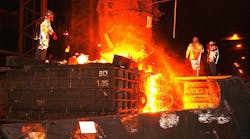Individuals exposed to moderate-to-high levels of silica have an increased risk of sarcoidosis and seropositive rheumatoid arthritis (RA), according to recently published study that evaluated the health of Swedish iron foundry workers. Per Vihlborg of the Örebro University Faculty of Medicine and Health, in Sweden, published “Risk of sarcoidosis and seropositive rheumatoid arthritis from occupational silica exposure in Swedish iron foundries: a retrospective cohort study,” in the journal BMJ Open.
The study may be expected to renew concerns about the risks of exposure to airborne silica (or silica dioxide, SiO2) in the workplace, which the federal Occupational Health and Safety Administration has determined is a cause of silicosis, lung cancer, chronic obstructive pulmonary disease, as well as kidney disease. OSHA implement a new rule to address the incidence of workers’ exposure to respirable crystalline silica, which will begin to be fully enforce in June 2018.
The Swedish research analyzed the effect of silica exposure on the prevalence of sarcoidosis and RA in a number of workers from 10 Swedish iron foundries, and compared those results with the general Swedish population.
Sarcoidosis involves collections of inflammatory cells that form lumps, usually beginning in the lungs, skin, or lymph nodes, though any organ may be affected. The usual symptoms are heavy coughing, shortness of breath, or chest pain. While sarcoidosis may be treated, the mortality rate is increased when it is observed in combination with other “interstitial lung diseases.” It is most commonly found in Scandinavians, though all populations may be affected.
Rheumatoid arthritis (RA) is an autoimmune disorder that primarily affects joints, with burning, swelling, and pain in the affected areas. People diagnosed with RA may also suffer from respiratory and pulmonary diseases as complications.
While silicosis is rare in Sweden, the effects of silica exposure combined with smoking has been associated with an increased risk of developing seropositive RA. According to a report on the study, because both sarcoidosis and RA are inflammatory disorders, the medical researchers hypothesized that similar environmental factors may be a common cause.
The study identified a cohort of 2,187 individuals who had been employed in a sand-casting foundry for at least one year before 2005. Most of the workers had started employment in the 1970s or 1980s, but some had started in the 1930s. Almost 40% had worked in foundries for over 10 years.
Just seven cases of sarcoidosis were reported, and distributed across all the foundries in the cohort. But, the results revealed that moderate-to-high levels of airborne silica exposure increased the risks of sarcoidosis and seropositive RA. This parallels findings from other studies.
The researchers noted that the mean levels of airborne silica dust in the foundries decreased significantly after the 1970s. As the prevalence of smoking also decreased over time, “the proportion of smokers (or ex-smokers) may be highest in the highly exposed group, which could affect the prevalence of RA,” the authors wrote.









